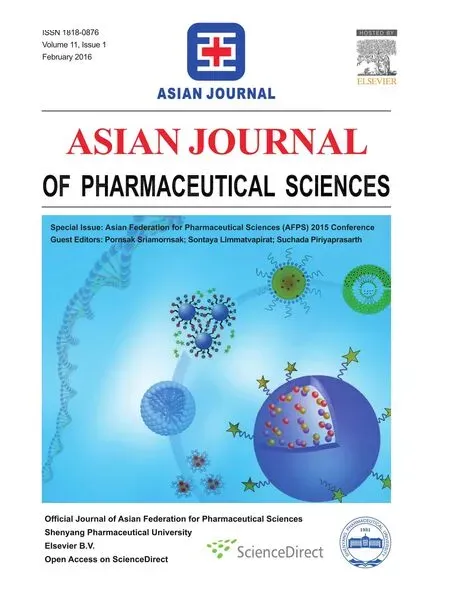Physicochemical characterization of gum from tamarind seed:Potential for pharmaceutical application
b
aFaculty of Pharmaceutical Sciences,Burapha University,Chonburi 20131,Thailand
bDepartment of Pharmaceutical Technology,Faculty of Pharmacy,Silpakorn University,Nakorn Pathom 73000, Thailand
cDepartment of Chemical Engineering,Faculty of Engineering,Burapha University,Chonburi 20131,Thailand
Physicochemical characterization of gum from tamarind seed:Potential for pharmaceutical application
Kampanart Huanbuttaa,*,Tanikarn Sangnima,b, Wancheng Sittikijyothinc
aFaculty of Pharmaceutical Sciences,Burapha University,Chonburi 20131,Thailand
bDepartment of Pharmaceutical Technology,Faculty of Pharmacy,Silpakorn University,Nakorn Pathom 73000, Thailand
cDepartment of Chemical Engineering,Faculty of Engineering,Burapha University,Chonburi 20131,Thailand
A R T I C L E I N F O
Article history:
Available online 25 November 2015
Tamarind seed gum
Dry binder
Tablets
Diclofenac sodium
Tamarind(Tamarindus indica Linn.)is a topical plant that is generally found and planted inThailand.Application of tamarind seed gum can increase the value of tamarind and minimize the industrial waste[1].Tamarind seed gum powder offers high viscosity solution.Therefore,researchers are interested in developing tamarind seed gum as binder in formulation of diclofenac sodium tablet,prepared by dry granulation method. Physicochemical characterization result rerated that the carboxymethylation process could add carboxymethyl group in the chemical structure of crude gum[2].The success of chemical modifcation was confrmed by FTIR result as presented in Fig.1A.As illustrated in Fig.1B,the power X-ray diffractogram expressed the gum in the form of crude,and modifcation was in amorphous form.Melting point,solubility properties and viscosity of the polymer solution increased after the chemical structure modifcation.However,the disintegration time of the tablet made of the modifed gum was too long.Consequently,appropriated amount of gum powder (40–70 mg/tablet)was optimized.The result found that hardness of the tablet did not depend on gum amount[3].Increasing portion of the gum in the formulation retarded disintegration time and drug dissolution.The proper amount of the modifed gum in the formulation was 60 mg(7.61%w/w).Hardness of the tablet was 61 N with 1.99%of tablet friability. Disintegration time was over than 15 minutes and drug release reached 76%in 20 minutes.
Acknowledgments
The authors acknowledge the fnancial support received from Faculty of Pharmaceutical Sciences,Burapha University.Theassistance for laboratory work by Kanoknat Nakhonthai, Benjawan Ninwalaikul and Suebpong Eampakun is greatly appreciated.

Fig.1–FTIR(A)and powder X-ray diffractrogram(B)of tamarind gum in crude and modifcation forms.
R E F E R E N C E S
[1]Prajapati VD,Jani GK,Moradiya NG,et al.Pharmaceutical applications of various natural gums,mucilages and their modifed forms.Carbohydr Poly 2013;92:1685–1699.
[2]Spychaj T,Wilpiszewska K,Zdanowicz M.Medium and high substituted carboxymethyl starch:synthesis,characterization and application.Starke 2013;65:22–33.
[3]Deodhar UP,Paradkar AR,Purohit AP.Preliminary evaluation of leucaena leucocephala seed gum as a tablet binder.Drug Dev Ind Pharm 1998;24:577–582.
*E-mail address:kampanart@buu.ac.th.
Peer review under responsibility of Shenyang Pharmaceutical University.
http://dx.doi.org/10.1016/j.ajps.2015.11.051
1818-0876/?2016 Production and hosting by Elsevier B.V.on behalf of Shenyang Pharmaceutical University.This is an open access article under the CC BY-NC-ND license(http://creativecommons.org/licenses/by-nc-nd/4.0/).
 Asian Journal of Pharmacentical Sciences2016年1期
Asian Journal of Pharmacentical Sciences2016年1期
- Asian Journal of Pharmacentical Sciences的其它文章
- Determination of the antidepressant effect of mirtazapine augmented with caffeine using Swiss-albino mice
- Photosafety testing of dermally-applied chemicals based on photochemical and cassette-dosing pharmacokinetic data
- Biopharmaceutics classifcation system(BCS)-based biowaiver for immediate release solid oral dosage forms of moxifoxacin hydrochloride (Moxifox GPO)manufactured by the Government Pharmaceutical Organization(GPO)
- Bioequivalence study of abacavir/lamivudine (600/300-mg)tablets in healthy Thai volunteers under fasting conditions
- Evaluation of cytotoxic and infammatory properties of clove oil microemulsion in mice
- Analytical method development of pregabalin and related substances in extended release tablets containing polyethylene oxide
